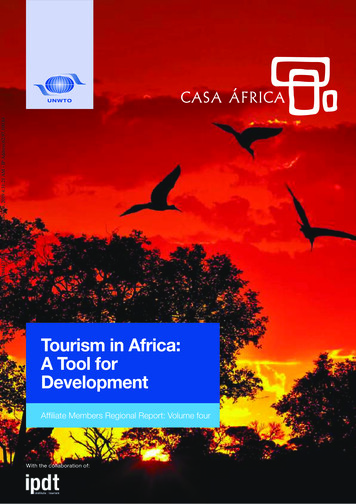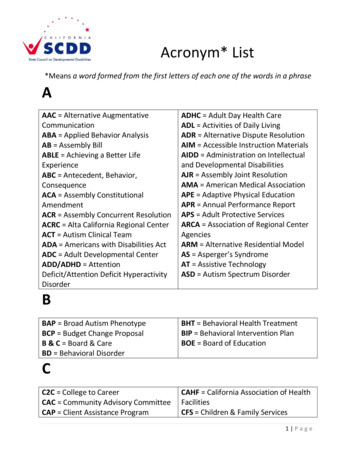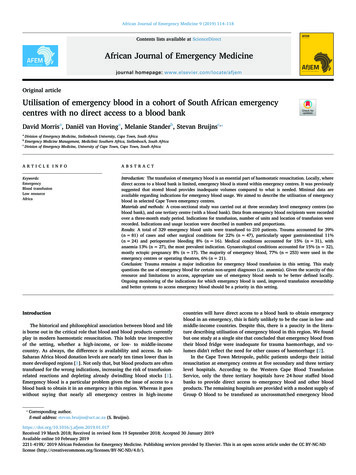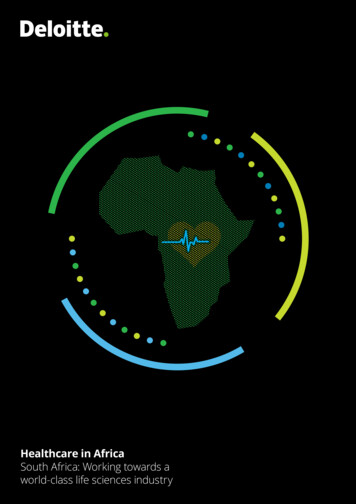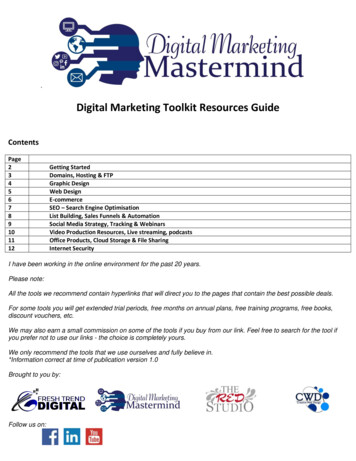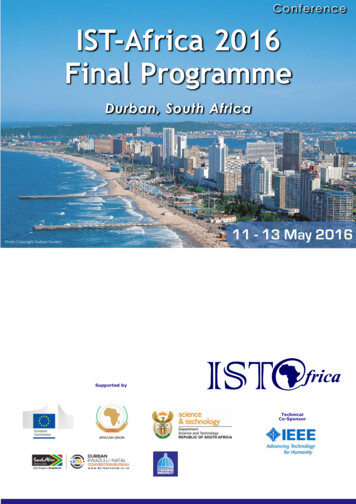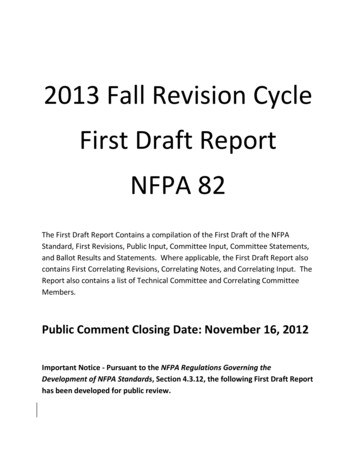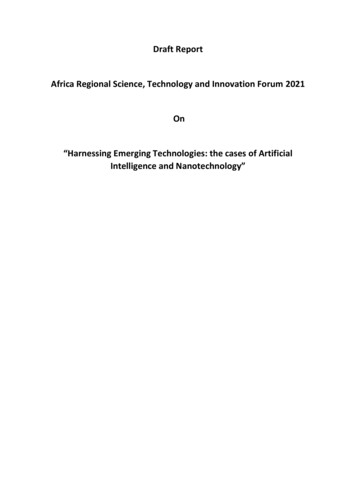
Transcription
Draft ReportAfrica Regional Science, Technology and Innovation Forum 2021On“Harnessing Emerging Technologies: the cases of ArtificialIntelligence and Nanotechnology”
1. IntroductionThe global pandemic caused by the severe acute respiratory syndrome coronavirus 2 (SARSCoV-2) of 2019 (the disease commonly referred to as COVID-19) has highlighted theimportance of technology and innovation in developed countries. Technology has enabledresearchers and firms to work at unprecedented speeds to decode the organism’s genetic codein weeks1, design testing, monitoring and patient management devices or tools, and bring tomarket several novel vaccines in about a year. Similarly, digital technologies have transformedhow people work, interact and access services. The demand for science to make informeddecisions and actions to manage the COVID-19 pandemic was high in both developed anddeveloping countries alike2. The ability of countries to acquire, generate, use, and upgradescientific knowledge and technology in general, or experiment with new and emerginginnovative solutions depends on their human, institutional, and financial capabilities.It is against this backdrop that the African Science Technology and Innovation Strategy forAfrica 2024 (STISA 2024) was adopted by the Heads of Government and States as thecontinental blueprint to guide STI development. Among others, STISA 2024 calls on memberStates to build the technical competences, invest in STI infrastructure, promote innovation andentrepreneurship and put in place national and regional STI policies. STISA 2024 also renewedthe call on member States to invest at least 1% of the gross domestic product (GDP) in researchand development (R&D). These targets are also restated in the 2030 Agenda for SustainableDevelopment and in the AU Agenda 2063 based on the recognition that these capabilities areprerequisites to enable technology serve as effective means of implementation.If the STISA-2024 targets are met, Africa may be a step closer to building its own soundtechnological and dynamic industrial base it can leverage to meet its ambitious Agenda 2063aspirations. For example, Africa desires to achieve ‘middle income status with manufacturingaccounting for 50% of the GDP and high-tech exports constituting at least 50% ofmanufactured exports, and its people enjoying a high standard of living and quality of life forall citizens and its natural resources managed in a sustainable manner’ (Agenda 2063). Suchtargets can only be met fully, equitably and sustainably if new and emerging technologies arefully embraced as they are transforming manufacturing and redefining high-tech exports.New technologies open opportunities to create new industries, deliver new services, expandexisting production systems, create incomes and reduce environmental degradation. Forinstance, steam and water powered systems ushered in mechanization (first industrialrevolution); electricity enabled mass production in manufacturing (second industrialrevolution) and; electronics and information technology brought about increased automationand digitalization of processes (third revolution). All these technological revolutions creatednew opportunities that have transformed the world. What will the world look like withoutelectricity3 or internet?The Fourth Industrial Revolution is likely to be driven by increased convergence of digital,biological and physical systems. Advances in material sciences are enabling the developmentof smarter, stronger, smaller and energy efficient devices and systems while artificialintelligence is enabling remote service delivery, increased automation of homes, offices andfactories and mass data analysis at incredible speeds. The highly anticipated COVID-191Wu F, Zhao S, Yu B, Chen YM, Wang W, Song ZG, Hu Y, Tao ZW, Tian JH, Pei YY, Yuan ML, Zhang YL,Dai FH, Liu Y, Wang QM, Zheng JJ, Xu L, Holmes EC, Zhang YZ (2020). A new coronavirus associated withhuman respiratory disease in China. Nature. doi: immersive/d41586-020-03437-4/index.html3Horvath, R. (1969) The Wandering Capitals of Ethiopia. The Journal of African History, 10 (2), 205-219. RetrievedFebruary 2, 2021, from http://www.jstor.org/stable/179511
vaccines will not have been available without the use of incredible technological systems thatintegrate biological, digital and physical elements that enabled a quick decoding of the geneticmakeup; identification of possible targets; rapid design of potential vaccines or simulations;analysis of the mountains of data from clinical trials and now helping in ensuring safe, fair andequitable access4.Emerging technologies promise to reduce the costs of undertaking research, offer endlessopportunities for innovations and present opportunities to catch up with leading nations.Specifically, two of these emerging technologies – digital and nanotechnology- offer Africancountries different opportunities to produce and use knowledge, build more sustainablebusinesses and communities; diversify economic activities and accelerate regional integrations.In this regard, the report looks at the state of emerging technologies in Africa in recent timesand the progress made. It then addresses the current growth trajectories from a scientific,technological as well as an economic perspective. It also discusses the potential benefits ofthese technologies for enhancing productivity and efficiency, human well-being andenvironmental t-opportunitiesand-challenges
2. Emerging Technologies and CompetitivenessTechnology is a major enabler of competitiveness in almost all sectors. Advances in technologyoften opens up new opportunities that drive innovation, emergence of new companies,improvement in the productivity and efficiency of existing ones. In recent times, the emergenceof the Internet ushered in new businesses such as Google and Amazon and enhanced theproductivity and efficiency of existing firms such as airlines, hotels, energy utilities and publicinstitutions. In an open market, emerging technologies promote competitiveness and growth atthe firm level by increasing speed (e.g. reducing the number of steps and time goods andservices are produced and delivered), reducing costs (e.g. reduced energy consumption),improving quality (e.g. corrosion free metals), enhanced social and environmental impact (e.g.lower waste production), in meeting regulatory requirements (e.g. elimination of manychemicals that destroy the ozone layer in refrigeration systems), among others.Emerging technologies tend to enhance many of the elements of competitiveness and in theprocess disrupt existing business models. The cases of improved hybrid seeds and fertilizersin increasing food production and averting hunger (e.g. the green revolution); the shippingcontainer in transforming the shipping of goods around the world at lower costs and faster;the mobile money in transforming the financial sectors and the biotechnology in bringing intreatments in healthcare perhaps highlight the importance of emerging technologies indriving competitiveness.While most of the improvements in competitiveness occur at firm-level (microeconomics),they explain most the variations in macroeconomic growth. The current trade disputebetween the United States and China may be related to mastery of emerging technologies andthe competitiveness they are conferring to firms and economic performance of the countries.The rapid growth of the Asian Tigers (and that of Japan) could be tied to their ability toparticipate in emerging technologies. It is nearly impossible to discuss the rise of Asian Tigerswithout the rise of microprocessors and the electronics whose technologies they acquired,mastered and became leading producers and innovators.This requires countries to put in place appropriate policies and regulations that enable firms toacquire, master and develop new and emerging as well as existing technologies. Such policiesmay address support for research and development (R&D), human capital development,technology transfer, financial start-ups and build technology infrastructure. This is reaffirmedby the “Report of the Conference of Ministers on the work of its fifty-second session”5 in whichthey called on ECA to “help member States to replicate good practices in digital economy” andon member States to “build their human and technological capacity” and “formulate integratedplans for the development of the digital and green economy”.3. Africa’s place in the global market of emerging technologiesThere is significant interest at the role of emerging technologies in driving Africa’stransformation and in meeting the global Sustainable Development Goals (SDGs). This reportlooks at some of the opportunities and challenges that emerging technologies present and thetechnological, industrial and policy capabilities needed to harness and manage emergingtechnologies. It focuses on two broad categories of emerging technologies: a) digital5Economic Commission for Africa Conference of African Ministers of Finance, Planning and EconomicDevelopment, Fifty-second session. Marrakech, Morocco, 25 and 26 March 2019.
technologies and b) material sciences with a focus on nanotechnology that ECA continues toundertake policy research and advisory services to member States.3.1Trends in Artificial IntelligenceThe digital economy is unpinned by several key technologies, some of which include artificialintelligent (AI), cloud computing, blockchain, Internet of Things (IoT), virtual reality, andaugmented reality. However, as UNCTAD noted, China and United States currently own 75%of patents on blockchain, account for half of global spending on IoT and their firms accountsfor three quarters of the global market of commercial cloud computing. As a result, China andthe United States account for 90% of the 70 largest digital platform while Africa and LatinAmerica account for a combined share of about one percent (1%). The battle for digitaleconomy supremacy is perhaps fuelling the current trade tensions between the United Statesand China.Artificial Intelligence (AI) is one of the digital technologies likely to have profound economic,social and environment contributions. The global market for AI is estimated to be growing atabout 32%-42% per year – a very fast pace. While the actual value of the AI global market issmall - worth about 27.2 billion in 2019, it is expected to hit between 267 billion and 312billion by 202767. Software, at 41%, accounts for a large share of the market for AI, followedby services and hardware. The rapid penetration of AI in every aspect of the society – fromadvertising to personal assistants on mobile phones and computers is driving demand and inreturn, investment in research and development for enhanced and novel services.Like other technologies, it is the contribution of AI to business performance and economicgrowth that is driving greater investments by governments and companies alike. For instance,one estimate suggests that by 2030, AI will “contribute up to 15.7 trillion to the globaleconomy”8. Of that, consumption of AI is estimated to account for 9.1 trillion and increasedproduction is likely to account for the 6.6 trillion. If Africa can only grab a 10% of the globalGDP contribution of AI, Africa could see its GDP add about 1.5 trillion by 2030 – about 50%of its current GDP – due to AI alone. As growth may imply creation of additional high valueand decent jobs, reduction in poverty, increased productivity of firms, better living conditionsand enhanced environmental wellbeing.Africa has all the right ingredients to capture a large share of AI driven economy to advanceits social and environmental wellbeing. It has a young, curious, tech savvy and entrepreneurialpopulation that is increasingly educated. The high education sector is growing at a very fastpace, growing middle class and increased integration of the continental economy.3.1.1. What is AI?It is perhaps necessary to define what AI may be and what it may not be. An oversimplifieddescription of AI is a collection of technologies that enable machines to learn, adapt and actalmost with human-like intelligence at incredible speeds. Approaches to AI include thinkingand acting humanly and/or rationally. Thinking and acting humanly is the approach toAI that simulates human or biological systems, while thinking and acting rationally isbeing able to do the right thing given known knowledge or conditions. It was on 11 May1997 IBM’s Deep Blue beat the Chess Grand Master - Garry Kasparov - and two decades later,computers developed by Google and HNH Entertainment Corp (Republic of Korea) artificial-intelligence-aimarket#: :text -sizing-the-prize-report.pdf7
defeated world champions at Go – a game more complex than chess – that highlighted thepower of AI. In these cases, the computers are taught (or learn) the steps and rules of the gameand then go ahead to create new ways of learning, making decisions and acting that they soonoutsmart their human opponents that traditionally rely on intuition and experience.AI may include systems that analyse massive amounts of data to make or inform decisionmaking in areas such as advertising, health, agriculture, manufacturing, education,transportation, among others. As COVID-19 has demonstrated, while governments andinstitutions depend on sharing official data, an AI-based start-up whose system can understand65 languages and has access to global air ticketing system predicted more accurately theCOVID-19 spread from China9. By picking up on chatter, travel patterns and nature ofinfections reported, BlueDot10 had predicted the spread of COVID-19 from China to cities inAsia and beyond, just like it did in the spread of zika virus from Brazil to United States.AI differs widely from simple automation, which may be enabling machines to undertakerepetitive human-like acts such as those in assembly lines of factories and in warehouses. Inthis case, machines are trained to perform a specific act perfectly and performs that act in thesame way repetitively until perhaps programmed to perform another task. Usually, allowing asystem to evolve on its own is limited to simulated environments where the outcomes can beobserved in order to measure how to apply such a system in the real world given someevolvability constraints. This is important especially where the desire is to make perfect copiesof the same product – a chip, lab test, car or drug. It may not be desirable to find machines onthe factory floor have made changes that regulators did not approve in the design of a drug ormedical device, for example. Simple automation is desired in such casesAI is a range of areas such as Machine Learning, Natural Language Processing, Image Analysisand Computer Vision, Fuzzy Systems, Evolutionary Computation, and Probabilistic Methods.Several hospitals now employ some form of AI to analyse images and make predictions basedon object recognition software, and many home assistants are taught to learn the house owner’svoice signature so that it can only take commands from the right person to open the door, switchoff lights etc. These are different areas of AI and are underpinned by various technologies. Fora detailed overview of some of the common areas of AI, see Table 1.Table 1: Examples on main AI areas and their descriptionAI AreasLarge-scaleMachine LearningDeep LearningNatural LanguageProcessingCollaborativeSystemsComputer Vision(Image Analytics)Algorithmic GameTheory and9DescriptionLarge-scale Machine Learning Design of learning algorithms, as well asscaling existing algorithms, to work with extremely large data sets.Model composed of inputs such as image or audio and several hidden layersof sub-models that serve as input for the next layer and ultimately anoutput or activation functionAlgorithms that process human language input and convert it intounderstandable representations.Models and algorithms to help develop autonomous systems that can workcollaboratively with other systems and with humans.The process of pulling relevant information from an image or sets of imagesfor advanced classification and analysis.Systems that address the economic and social computing dimensions of AI,such as how systems can handle potentially misaligned incentives, global/10
ComputationalSocial ChoiceSoft Robotics(Robotic rested human participants or firms and the automated AI-basedagents representing them.Automation of repetitive tasks and common processes such as IT, customerservicing and sales without the need to transform existing IT system maps.Systems that address the optimization problems such as detecting the bestnetwork to connect to or optimizing trade-offs between two or morefactors, e.g The Travelling Salesman Problem. Evolutionary algorithms suchas Genetic Algorithms, and Genetic Programming.NeuroevolutionSystems that address sub-optimization to solve dynamic problems oraddress strategic planning such as in evolutionary robotics, usingevolutionary computation techniques such as genetic algorithms to evolvestructures of artificial neural networks.Source: Rao, A.S. and Verweij, G. (2017) Sizing the prize: what’s the real value of AI for yourbusiness and how can you capitalise?, PwC and updates by )3.1.2 AI potential and challenges in Africa.Research has shown that AI has the potential to solve some of the most pressing challengesfacing Africa and drive sustainable development in agriculture, health, infrastructure, financialand public services11. These are also some of the areas where the needs are high. Applicationsof AI may include modelling, detecting and tracking changes in the environment that could aiddecision making to make industries and businesses more efficient, productive and profitable;service delivery more effective and; knowledge more accessible.It is important for government to support research and development, technology acquisitionand infrastructure development fit for the digital economy is Africa has to realize the immenseopportunities offered by AI. For instance, global investment in AI start-ups has grown from 1.3 billion in 2010, to 37.4 billion by 2019 (an average annual growth rate of about 48%);AI computing power has doubled every 3.4 months; 58%of large businesses adopted AI insome of their operations (up from 47% in 2018) and 21% of graduating PhDs specialized inAI/Machine Learning12. Africa needs to match and outperform the global averages if it canaddress some of the key challenges.Among the key challenges that African countries need to address are:a)build the work force that is read for AI by addressing the education and quality ofresearch and development (R&D) systems to ensure they are fit for purpose, innovativeand entrepreneurial in nature,b)encourage the public and private sector to collaborate in design of AI solutions,preferably locally to ensure learning takes place and trust is built,c)promote open data and open access data and open government data principles toencourage research and businesses to build smart systems,d)increase funding and investment in high-speed internet and cloud computinginfrastructure with the security, speed and processing powers that AI demands and,e)development of national and regional strategies that ensure a good balance betweenethical and safety concerns and the research and business development interests.11University of Pretoria (2018) Artificial Intelligence for Africa: An Opportunity for Growth, Development, andDemocratisation, Access Partnership (12Stanford University (2019) AI Index Report 2019, Stanford Human Centred Artificial t/files/ai index 2019 report.pdf)
The main advantage is that Africa is not starting from a scratch but just from a low base. Almostall countries in Africa have a university or universities with computer science, mathematicsand/or engineering departments that could easily include AI in their teaching and researchprogrammes, businesses that are exploring AI applications (e.g. financial, insurance, travel andhospitality industries etc) and government units that are or could incorporate AI in theirservices (e.g. education, health, public utilities). In addition, countries such as Egypt, Ghana,Kenya, Senegal and South Africa have attracted some of the world’s top digital firms to set upresearch units that develop AI products.3.2Trends and steps to harness nanomaterials and nanotechnology13This overview offers a glimpse at what is included in nanotechnology, the currentnanotechnology research and development (R&D) trends and market potential and indirectlyassesses Africa’s participation in nanotechnology industry. It also highlights the sustainabledevelopments goals (SDGs) that nanotechnology is likely to have a greater impact and stepsAfrican countries can take to develop and realise the nanotechnology potential.3.2.1 Concepts, definitions and marketsNanotechnology has been termed ‘pervasive’, ‘enabler’ and ‘key driver’ of the next industrialrevolution. The nanotechnology value chain (See table 2) ranges from the tools needed tomanipulate matter at nanoscale to finished products that incorporate nanomaterial. It is nearlyimpossible to avoid products that includes some aspects of nanotechnology in the marketplace– it is found in washing machines and washing detergents, cosmetics, medicines, foodpackaging, electronic products, computers and mobile phones, among others.Table 2: Nanotechnology industry value nabledDescriptionEquipmentandsoftware for visualizing,manipulatingandmodellingUnprocessed forms ofnanoscale structuresIntermediateproductswithnanoscale ampleNanoimprintlithography equipmentNanoparticles, quantumdots and nanotubesMemory and edicine,carsdevices,plastics,Source: Michael Berger (2017) Debunking the trillion dollar nanotechnology market sizehype, Nanowerk. (https://www.nanowerk.com/spotlight/spotid 1792.php)The OECD defined nanotechnology as “the understanding of processes and phenomena andthe application of science and technology to organisms, organic and inorganic materials, aswell as parts, products and models thereof, at the nanometre-scale (but not exclusively below100 nanometres) in one or more dimensions, where the onset of size-dependent phenomena13This section is primarily based on the outcome of the Expert Group Meeting on ‘An African Nanotechnologyfuture? Policies and Regulations”
usually enables novel applications.” Nanotechnology include nanomaterials, nanoelectronics,nanophotonics, nanomedicine, nanomagnetics, and nanomechanics.In brief, nanotechnology refers to manipulation of matter at nano-scale (about a billionth of ameter) at which matter exhibits different chemical and physical properties from those at everyday scale. For instance, silver oxide is white at normal scale but transparent at nanoscale andcarbon will conduct electricity at nanoscale. It is these changes in the properties of matter atnanoscale that are behind the decreasing size of chips in mobile phones, computers and cars,improvements in drug targeting of cancer treatment with minimal side-effects, advance incleaning materials and surfaces that repel dirt, packing material that kill bacteria, filters thatclean air and water with minimal energy use, among others.It is these developments that are driving growth in nanotechnology-enabled products. Forinstance, the National Research Foundation supported research by Lux Research Inc concludedthat revenues from nanotechnology enabled-products increased from US 850 million in 2012to about 1.6 trillion in 2014 – a growth of about 90%14. The strong growth in nanotechnologymarket is partly driven by increasing investment in R&D that is bringing new industrialapplications at a very rapid pace. The number of nanotechnology related science publicationshave grown from about 13,000 in 1997 to 154,000 in 2016 – a 14% annual growth rate (Zhang,2017)15 and way higher than the estimated 3.7% annual growth rate in research papers acrossall fields of research during that same time. A number of developing countries (e.g. China, Iran,Saudi Arabia) are among the top R&D performing countries in nanotechnology. Africancountries such as Egypt, Tunisia and South Africa are making steady investment innanotechnology.Figure 1: Nanotechnology articles by the top 10 African countries2000EgyptSouth 22004200620082010201220142016201814Lux Research (2015) Nanotechnology Update: U.S. Leads in Government Spending Amidst IncreasedSpending Across Asia, Lux Research Inc.15Zhang Li (2017) Nanoscience as a microcosm of the success of Chinese science; Springer Nature,
Source: Statnano databaseThis is also reflected in the number of patents in the USPTO and EPO. Between 2001 and 2017,about 141,170 patent applications were filed with the two offices. The United States remainsthe largest contributor followed by Korea, Japan and Germany. Between 2010 and 2017, thefastest growth rate was posted by Saudi Arabia (about 2000% from 8 to 167 applications),followed by China (143%) and Korea (71%). However, most of the mature economiesregistered modest growth rates during this period.At the continental level, South Africa has 87 patent applications for nanotechnology-relatedinventions filed in the USPTO and only seven in the EPO between 2001 and 2017. All of the40 patent applications of Egypt were filed in the the USPTO. Although a growth in the numberof patent applications is observed in the few African countries, it remains uneven and rathersmall. For instance, Saudi Arabia applied for more nanotechnology patents in 2017 in theUSPTO than South Africa or Egypt did in the last 17 years (Figure 2). The continent seem tobe lagging behind.Figure 2: Patent applications by African countries (Sum of 2001-2017)1009080706050403020100912001-1740South Source: Statnano database3.2.2 Nanotechnology and the Sustainable Development GoalsAlthough nanotechnology will impact all aspects of life, its greater impact is likely to be onSDGs 2 (Food), SDG 3 (Health), SDG 7 (Energy), SDG 8 (Employment), SDG 9(Infrastructures/innovation), SDG 11 (cities) and SDG 12 (Responsible Consumption) wheremost of the private investment in R&D is targeted. It is these areas where patents granted andhigh impact technologies by applications are concentrated. However, its impact on other SDGswill be equally important but likely to be indirect unless the continent invests in keynanotechnology applications with limited industrial interest (e.g. water, climate change andpeace and security).In general, emerging technologies present significant opportunities for the continent to catchup with leading countries before entry barriers become steep. For instance, several largebusinesses exploring markets are more likely to partner with African countries now than afterthe markets elsewhere have matured, standards have been established and intellectual assets
are tightly controlled. This was clearly demonstrated by Internet and mobile phone revolutions.African start-ups got support from partners everywhere with limited restriction and grewrapidly. The success of these early entrants led to increased demand for higher standards, firmerregulations, and increased competition from larger foreign firms.3.2.3 Key steps to harness nanotechnology for developmentCapacity Building Initiatives in Nanotechnology is EmergingA number of African countries have designed and others are in the process of designing andimplementing national nanotechnology strategies and initiatives. Frontrunners such as SouthAfrica can help drive nanotechnology capacity building for industrial (e.g. processing,bioprocessing, and manufacturing) and social (clean water, energy, and primary healthcare)sectors. African countries should take steps to develop nanotechnology policies, strategies andpolicies, and use the budding nanotechnology research centres to build their nanotechnologycapacity in selected areas with greater chances of success.Building Regional Research and Industrial Networks in NanotechnologyIn the context of the emerging Africa Continental Free Trade Area as well as in the rise ofregional science, technology and innovations activities at RECs levels, regional blocks canserve as vehicles for developing common strategies, research infrastructure, innovation spacesand industrial nanotechnology platforms. Currently, African countries are largely collaboratingmore with partners outside the continent than their neighbours. Measures to create a platformor inventory of nanotechnology research facilities and experts could enhance intra-regionalcollaboration; and efforts to promote intra-African collaboration in building nanotechnologyresearch, innovation and entrepreneurship.Addressing social and regulatory challenges of nanotechnology in AfricaNanotechnology poses many social and regulatory challenges for developed and developingcountries alike. The absence of a globally agreed regulatory regime to manage the risks anduncertainties pose
Africa's place in the global market of emerging technologies There is significant interest at the role of emerging technologies in driving Africa's transformation and in meeting the global Sustainable Development Goals (SDGs). This report looks at some of the opportunities and challenges that emerging technologies present and the
